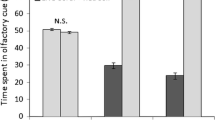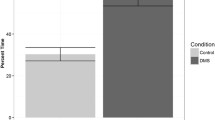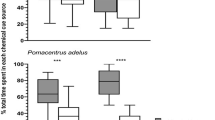Abstract
Sensory abilities and preferences exhibited by mobile larvae during their transition to juvenile habitats can establish spatial heterogeneity that drives subsequent species interactions and dynamics of populations. We conducted a series of laboratory and field experiments using coral reef fish larvae (Chromis viridis) to determine: ecological determinants of settlement choice (conspecifics vs. heterospecifics vs. coral substrates); sensory mechanisms (visual, acoustic/vibratory, olfactory) underlying settlement choice; and sensory abilities (effective detection distances of habitat) under field conditions. C. viridis larvae responded positively to visual, acoustic/vibratory, and olfactory cues expressed by conspecifics. Overall, larvae chose compartments of experimental arenas containing conspecifics in 75% of trials, and failed to show any significant directional responses to heterospecifics or coral substrates. In field trials, C. viridis larvae detected reefs containing conspecifics using visual and/or acoustic/vibratory cues at distances <75 cm; detection distances increased to <375 cm when olfactory capacity was present (particularly for reefs located up-current). We conducted high performance liquid chromatography (HPLC) analyses of seawater containing C. viridis juveniles and isolated high concentrations of several organic compounds. Subsequent laboratory trials demonstrated that C. viridis larvae responded positively to only one of these organic compounds. This compound was characterized by a weak polarity and was detected at 230 nm with a 31-min retention time in HPLC. Overall, our results suggest that fishes may use a range of sensory mechanisms effective over different spatial scales to detect and choose settlement sites, and species-specific cues may play a vital role in establishment of spatial patterns at settlement.




Similar content being viewed by others
References
Allen GR (1991) Damselfishes of the world. Mergus, Germany
Baker CF, Montgomery JC (2001) Species-specific attraction of migratory banded kokopu juveniles to adult pheromones. J Fish Biol 8:1221–1229
Booth DJ (1992) Larval settlement patterns and preferences by domino damselfish Dascyllus albisella gill. J Exp Mar Biol Ecol 155:85–104
Browne KA, Zimmer R (2001) Controlled field release of a waterborne chemical signal stimulates planktonic larvae to settle. Biol Bull 200:87–91
Connell SD, Jones GP (1991) The influence of habitat complexity on post-recruitment processes in a temperate reef fish population. J Exp Mar Biol Ecol 151:271–294
Doherty PJ (2002) Variable replenishment and the dynamics of reef fish populations. In: Sale PF (ed) Coral reef fishes: dynamics and diversity in a complex ecosystem. Academic, San Diego, pp 327–358
Dudley B, Tolimieri N, Montgomery J (2000) Swimming ability of the larvae of some reef fishes from New Zealand waters. Mar Freshw Res 51:783–787
Dufour V, Galzin R (1993) Colonization patterns of reef fish larvae to the lagoon at Moorea Island, French Polynesia. Mar Ecol Prog Ser 102:143–152
Elliott JK, Elliott JM, Mariscal RN (1995) Host selection, location, and association behaviors of anemone fishes in field settlement experiments. Mar Biol 122:377–389
Fontaine M, JeanJean S, Monzikoff A (1982) Intervention possible de la riboflavine (vitamine B2) comme télémédiateur chimique dans les écosystèmes aquatiques. C R Acad Sci Ser III:165–167
Galzin R, Pointier JP (1985) Moorea Island, Society archipelago. In: Proceedings of 5th International Coral Reef Symp, vol 1, pp 75–101
Gebauer P, Paschke K, Anger K (2002) Metamorphosis in a semiterrestrial crab, Sesarma curacaoense: intra and interspecific settlement cues from adults’ odors. J Exp Mar Biol Ecol 268:1–12
Janssen J, Jones WR, Whang A, Oshel PE (1995) Use of the lateral line in particulate feeding in the dark by juvenile alewife (Alosa pseudoharengus). Can J Fish Aquat Sci 52:358–363
Kaus S (1987) The effect of aminoglycoside antibiotics on the lateral line organ of Aplocheilus lineatus (Cyprinodontidae). Acta Otolaryngol 103:291–298
Kingsford MJ, Leis JM, Shanks A, Lindeman K, Morgan S, Pineda J (2002) Sensory environments, larval abilities and local self-recruitment. Bull Mar Sci 70:309–340
Lecchini D (2003) Identification of habitat use strategies between the colonization and recruitment stages of coral reef fish in the lagoon of Moorea (French Polynesia): approach by behavioral ecology. PhD Thesis, University of Pierre and Marie Curie
Leis JM, Carson-Ewart BM (1997) In situ swimming speeds of the late pelagic larvae of some Indo-Pacific coral reef fishes. Mar Ecol Prog Ser 159:165–174
Leis JM, Carson-Ewart BM, Cato DH (2002) Sound detection in situ by the larvae of a coral reef damselfish (Pomacentridae). Mar Ecol Prog Ser 232:259–268
Liang XF, Liu JK, Huang BY (1998) The role of sense organs in the feeding behavior of Chinese perch. J Fish Biol 52:1058–1067
Mant CT, Hodges RS (1991) High-performance liquid chromatography of peptides and proteins: separations, analysis, and conformation. CRC Press, Boston
Myrberg AA, Fuiman LA (2002) The sensory world of coral reef fishes. In: Sale PF (ed) Coral reef fishes: dynamics and diversity in a complex ecosystem. Academic, San Diego, pp 123–148
Natunewicz CC, Epifanio CE, Garvine RW (2001) Transport of crab larval patches in the coastal ocean. Mar Ecol Prog Ser 2001:143–154
Ohman MC, Rajasuriya A, Olafsson E (1997) Reef fish assemblages in north-western Sri Lanka: distribution patterns and influences of fishing practices. Environ Biol Fish 49:45–61
Painter SD, Clough B, Garden RW, Sweedler JV, Nagle GT (1998) Characterization of Aplysia attractin, the first water-borne peptide pheromone in invertebrates. Biol Bull 194:120–131
Pawlik JR (1992) Chemical ecology of the settlement of benthic marine invertebrates. Oceanography Mar Biol Annu Rev 30:273–335
Poulin E, Palma AT, Leiva G, Narvaez D, Pacheco R, Navarrete SA, Castilla JC (2002) Avoiding offshore transport of competent larvae during upwelling events: the case of the gastropod Concholepas concholepas in Central Chile. Limnol Oceanogr 47:1248–1255
Schmitt RJ, Holbrook SJ (1996) Local-scale patterns of larval settlement in a planktivorous damselfish: do they predict recruitment? Aust J Mar Freshw Res 47:449–463
Schmitt RJ, Holbrook SJ (1999) Mortality of juvenile damselfish: implications for assessing processes that determine abundance. Ecology 80:35–50
Shima JS (2001a) Recruitment of a coral reef fish: roles of settlement, habitat, and post-settlement losses. Ecology 82:2190–2199
Shima JS (2001b) Regulation of local populations of a coral reef fish via joint effects of density- and number-dependent mortality. Oecologia 126:58–65
Shima JS, Osenberg CW (2003) Cryptic density dependence: effects of covariation between density and site quality in reef fish. Ecology 84:46–52
Sola C, Spampanato A, Tosi L (1993) Behavioural responses of glass eels (Anguilla anguilla) towards amino acids. J Fish Biol 42:683–691
Sponaugle S, Cowen RK, Shanks A, Morgan SG, Leis JM, Pineda J, Boehlert GW, Kingsford MJ, Lindeman KC, Grimes C, Munro JL (2002) Predicting self-recruitment in marine populations: biophysical correlates and mechanisms. Bull Mar Sci 70:341–375
Stobutzki IC, Bellwood DR (1997) Sustained swimming abilities of the late pelagic stages of coral reef fishes. Mar Ecol Prog Ser 149:35–41
Sweatman H (1983) Influence of conspecifics on choice of settlement sites by larvae of two pomacentrid fishes (Dascyllus aruanus and D. reticulatus) on coral reefs. Mar Biol 75:225–229
Sweatman HPA (1988) Field evidence that settling coral reef fish larvae detect resident fishes using dissolved chemical cues. J Exp Mar Biol Ecol 124:163–174
Tolimieri N, Sale PF, Nemuth RS, Gestring KB (1998) Replenishment of populations of Caribbean reef fishes: are spatial patterns of recruitment consistent through time? J Exp Mar Biol Ecol 230:55–71
Tolimieri N, Jeffs A, Montgomery JC (2000) Ambient sound as a cue for navigation by the pelagic larvae of reef fishes. Mar Ecol Prog Ser 207:219–224
Tupper M, Boutilier R (1997) Effects of habitat on settlement, growth, predation risk and survival of a temperate reef fish. Mar Ecol Prog Ser 151:225–236
Tupper M, Hunte W (1994) Recruitment dynamics of coral reef fishes in Barbados. Mar Ecol Prog Ser 108:225–235
Acknowledgements
The authors wish to thank N. Phillips, and two anonymous reviewers for their comments improving the quality of this manuscript, and J. Algret and Y. Chancerelle for their assistance in the field. This research was supported by the Ecole Pratique des Hautes Etudes, and a Lavoisier Fellowship (French Ministry to Foreign Affairs) awarded to D. Lecchini. Additional logistic and financial supports were provided by the Centre de Recherches Insulaires et Observatoire de l’Environnement (CRIOBE), the Gump Research Station, and an NSF grant (OCE-0242312) and a New Zealand ISAT Linkage Grant supporting the involvement of the J. Shima. This work is a joint contribution from the CRIOBE and Gump Research Stations, both located on Moorea.
Author information
Authors and Affiliations
Corresponding author
Rights and permissions
About this article
Cite this article
Lecchini, D., Shima, J., Banaigs, B. et al. Larval sensory abilities and mechanisms of habitat selection of a coral reef fish during settlement. Oecologia 143, 326–334 (2005). https://doi.org/10.1007/s00442-004-1805-y
Received:
Accepted:
Published:
Issue Date:
DOI: https://doi.org/10.1007/s00442-004-1805-y




